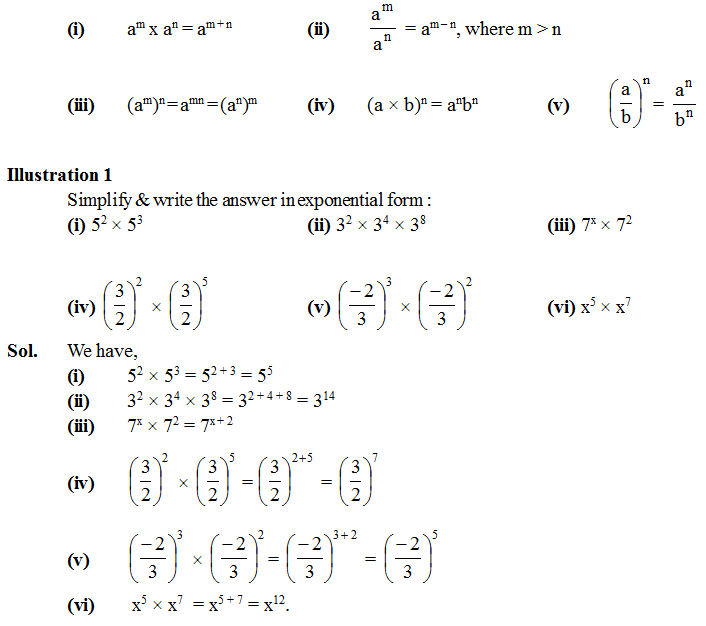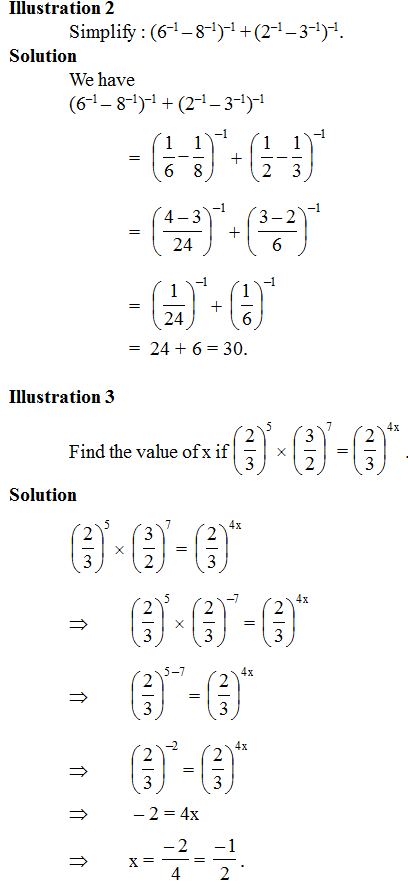1. Exponents and Powers
- Books Name
- class 7 Mathematics Book
- Publication
- ReginaTagebücher
- Course
- CBSE Class 7
- Subject
- Mathmatics
Chapter – 13
Exponents and Powers
Power is the product of multiplying a number by itself. It shows how many times the base is multiplied by itself.
The base number tells what number is being multiplied.
The exponent, a small number written above and to the right of the base number, tells how many times the base number is being multiplied.
The number 5 is called the base, and the number 2 is called the exponent.
An exponent is a small number written above and to the right of the base number, tells how many times the base number is being multiplied.
The base a raised to the power of n is equal to the multiplication of a, n times:
a⋅a⋅a⋅...⋅a = an
a is the base and n is the exponent.
For example, “3 to the power 4” may be written as 34. Here, the base number is 3, and the exponent is 4. It means that 3 is being multiplied by itself 4 times: 3 x 3 x 3 x 3.
Where,
3 x 3 x 3 x 3 = 81 or 34 = 81.
The positive value of a positive integer is always positive.
A negative number is positive if the multiplier is an even number and negative if the multiplier is an odd number.
- 'a' square or 'a' in the second stage:
a2=a⋅ a
- 'a' cube or 'a' in the third stage:
a3= a⋅ a⋅ a
- 'a' in the fourth stage:
a4 = a⋅ a⋅ a⋅ a
A fraction with a whole negative multiplier is taken to be a fraction with a numerator of 1, but the denominator is the same base with the opposite positive multiplier.
a−n=1an (n−naturalnumbers)
an⋅am=an + m;an:am = an−m,n> m,a ≠ 0;(an)m=an⋅m
Where n and m are integers.
The normal form of a number is called the multiple of this number: a⋅10nwhere1 ≤ a < 10
Note that greater than 1 and less than 10.
When dividing degrees with the same base, the powers are subtracted, and the base remains unchanged.
an:am=an−m
Where a≠0, n and m are natural numbers such that n>m.
2. Laws of exponents
- Books Name
- CBSE Class 7 Mathematics Book
- Publication
- Param Publication
- Course
- CBSE Class 7
- Subject
- Mathmatics
Base and Exponent
If a is a non-zero rational number and n is a natural number, then the product a × a × a × ... up to n times is denoted by an and is read as 'a raised to the power n'. Rational number 'a' is called the base and natural number ‘n’ is known as the exponent. Also, an is known as the exponential form of
a × a × a × ... up to n times.
For any non-zero rational number, we have :
a0 = 1 and a1 = a.
3. Miscellaneous examples using the laws of exponents
- Books Name
- CBSE Class 7 Mathematics Book
- Publication
- Param Publication
- Course
- CBSE Class 7
- Subject
- Mathmatics
Laws of exponents
If a and b are non-zero rational numbers and m and n are natural numbers, then following are the laws of exponents :



 ReginaTagebücher
ReginaTagebücher
 Param Publication
Param Publication
